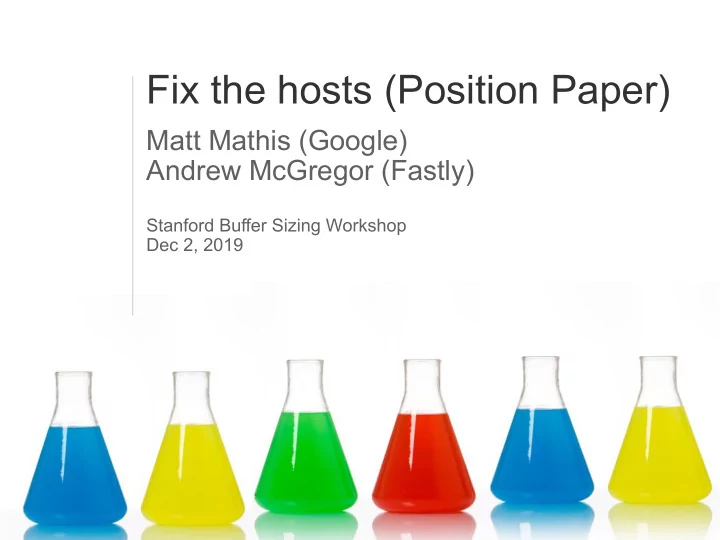

Fix the hosts (Position Paper) Matt Mathis (Google) Andrew McGregor (Fastly) Stanford Buffer Sizing Workshop Dec 2, 2019
Punchline At the largest scales we can not afford "properly" sized buffers ● They will be perpetually doomed by Moore's law ● It is far more cost effective to fix the end systems ○ Pacing at scale ○ BBR is a good start My charge to this community: invert the question. Given buffer sizes are smaller than we would prefer, how can we maximize effective network capacity and efficiency?
Moore's law Colloquially: Speed-complexity product doubles every 18 Months. Networks link rates double every 2 years ● Buffer speed has to double every 2 years ● Buffer size has to double every 2 years ● Buffer speed-complexity product needs to quadruple every 2 years But this is economically infeasible in the fastest parts of the Internet So drain times keep falling ● Sub mS is becoming more common
Why do we want large buffers? ● Many reasons.... but we dwell on one. ● [VJ88] Design principles: ○ Packet conservation and TCP self clock ■ Vast majority of transmissions are triggered by ACKS ○ Explicitly stated: the entire TCP system is clocked by packets flowing through the bottleneck queue ○ This clearly works when buffer size > Bandwidth-Delay-product ○ But does this really work when the buffer size is only 1% of the BDP? ■ The clock source (the bottleneck) does not have enough memory to significantly spread or smooth bursts
BBR: new first principles for Congestion Control ● BBR builds an explicit model of the network ○ Estimate max_BW and min_RTT ● The BBR core algorithm: ○ By default pace at a previously measured Max_BW ○ Dither the pacing rate to measure model parameters ■ Up to observe new max rates ■ Down to observe the min RTT ■ Gather other signals such as ECN ● BBR's "personality" is determined by the heuristics used to dither the rates and perform the measurements ○ These heuristics are completely unspecified in the core algorithm
BBR TCP Server Client (10 Gb/s) (1 Mb/s) One 100 Gb/s strand of Router at the access Core switch with 1mS a 1.2 Tb/s Link edge with large drain time and Aggregation Group buffers and AQM flow pinned ECMP (LAG). Assume 50 mS RTT and that the return path batches or thins ACKs. ● TCP estimates max_BW (at far edge) and min_RTT (entire path) ● Servers send at ~1Mb/s per client (dithered to measure bottleneck) ● Traffic is smoother than Markov at some scales ○ Nominally no standing queues in the core ● No loss in the core except true overload or pathological pacing synchronization (extremely unlikely)
Self clock is not good in a short queue Internet Server Client (10 Gb/s) (1 Mb/s) One 100 Gb/s strand of Router at the access Core switch with 1mS a 1.2 Tb/s Link edge with large drain time and Aggregation Group buffers and AQM flow pinned ECMP (LAG). Assume 50 mS RTT and that the return path batches or thins ACKs. ● Server rate bursts are delivered all the way to the far access edge ○ Where the bottleneck clocks the entire system ○ ACK thinning or compression causes persistent server rate bursts ■ e.g. WiFi and LTE channel arbitration ● Concurrent bursts from 11 servers will cause queues in the core ● Pathological ACK synchronization can cause loss at 2% load ● The details of the burst structure come from weakly bound properties ○ Average window size, mechanisms that retime ACKs, etc
Deprecating VJ88 has profound implications ● 30yrs of research on window based CC w/ self clock ○ Some things that we think we "know" are wrong ○ There might be gold in some ideas that were abandoned ○ Pretty much everything needs to be revisited ● Conjectures: ○ BBR framework easily adapts to multiple modeling strategies ○ Most window based CC algorithms have paced equivalents ○ Some CC algorithms fit even a better (e.g. chirping) ○ 20 years of past CC work needs to be ported into BBR See: Mathis & Mahdavi "Deprecating the TCP Macroscopic Model" [CCR Oct 2019]
Buffer Sizing Research questions ● Ongoing improvements to BBR ● Quantify the impact of bursty traffic on other traffic ○ What does it cost? buffer space or extra headroom (wasted capacity)? ○ Can ISPs incentivize reducing bursty traffic? ● Are there alternatives besides pacing vs self clocked TCP? ● Does application transaction smoothing help? ○ BBR natively restarts at the old max_BW. Should that decay? ● Does ECMP still need flow pinning? ○ Paced packets are less likely to be reordered due to path diversity. ○ How much would it save us to discard flow pinning?
Conclusions ● Moore's law squared dooms large buffers ● Small buffers doom self clocked protocols ● Some form of pacing is inevitable ○ BBR is a good start, but long from done ○ Large content providers already have incentives ■ BBR solves real problems for them
Recommend
More recommend